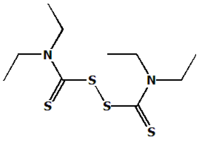Disulfiram
Disulfiram is a drug used to support the treatment of chronic alcoholism by producing an acute sensitivity to alcohol. Trade names for disulfiram in different countries are Antabuse® and Antabus®. more...
Under normal metabolism, alcohol is broken down in the liver by the enzyme alcohol dehydrogenase to acetaldehyde, which is then converted by the enzyme acetaldehyde dehydrogenase to the harmless acetic acid. Disulfiram blocks this reaction at the intermediate stage by blocking the enzyme acetaldehyde dehydrogenase. After alcohol intake under the influence of disulfiram the concentration of acetaldehyde in the blood may be 5 to 10 times higher than that found during metabolism of the same amount of alcohol alone. As acetaldehyde is one of the major causes of the symptoms of a "hangover" this produces immediate and severe negative reaction to alcohol intake. Some 5-10 minutes after alcohol intake, the patient may experience the effects of a severe hangover for a period of 30 minutes up to several hours.
Disulfiram should not be taken if alcohol has been consumed in the last 12 hours. There is no tolerance to disulfiram: the longer it is taken, the stronger its effects. As disulfiram is absorbed slowly through the digestive tract and eliminated slowly by the body the effects may last for up to 2 weeks after the initial intake. Clearly, patients must be fully informed about the disulfiram-alcohol reaction.
The drug's action was discovered by accident in the 1940s in the Danish drug company Medicinalco: workers testing the substance, which was intended to treat parasitic diseases, on themselves reported severe symptoms after alcohol consumption.
One weakness with Disulfiram and similar treatments is that if not taken under supervision an alcoholic will often not stick to the treatment, since it is easier to give up the drug than alcohol. Even when strictly taken the negative effects will rarely break the drinking patterns of a chronic alcoholic. In some extreme cases, patients with subcutaneous disulfiram tablet implants have been known to cut or dig out the tablet to avoid its effects. For these reasons disulfiram is not in itself a cure for alcoholism and is usually only indicated for select patients who wish to remain in an enforced state of sobriety during other forms of treatment, such as support groups and psychotherapy.
Similarly acting substances
Coprine, a closely related chemical having the same metabolic effects, occurs naturally in several edible mushroom species, such as the inky cap.
Temposil, or citrated calcium carbamide, has the same function as Antabuse but is weaker and safer.
Read more at Wikipedia.org



